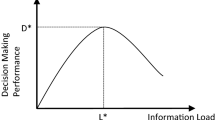Abstract
This study addresses an empirical analysis of information- and knowledge-sharing among collaborative decision makers. In this research, each decision maker represents one of three distributed centers in ERP systems: Sales, Production, and Procurement Centers. Their respective objectives and decision policies are defined to design collaborative decision-making environments. MICSS-LAN, an ERP simulation tool, was applied for the experiments, generating explicit numerical results that enable the measurement of the effectiveness and benefits by collaborative decision making. The experimental results indicate that total profit and due date performance have been improved by information- and knowledge-sharing. It implies that better design and utilization of ERP structures can be achieved by a certain level of information- and knowledge-sharing.
Similar content being viewed by others
References
Anussornnitisarn P., Nof S. Y. (2003) e-Work: The challenge of the next generation ERP systems. Production Planning and Control 14(8): 753–765
Anussornnitisarn P., Nof S. Y. (2005) Etzion O. Decentralized control of cooperative and autonomous agents for solving the distributed resource allocation problem. International Journal of Production Research 98(2): 114–128
Ceroni J. A., Matsui M., Nof S. Y. (1999) Communication based coordination modeling in distributed manufacturing systems. International Journal of Production Economics 31(9): 851–864
Ceroni J. A., Nof S. Y. (2005) Task parallelism in distributed supply organizations: a case study in the shoe industry. Production Planning and Control 16(5): 500–513
Chen, J., & Nof, S. Y. (2001). Design of scalable and optimal multi-enterprise networking. Proceedings of ICPR-16, Prague, CR.
Chen, J., Yerushalmy, M., Ward, J. E., & Nof, S. Y. (2001) The use of MICSS/MERP, an ERP model, in education and research. Proceedings of IFAC workshop on manufacturing, modeling for management and control, Prague, CR.
Dube, K., Mansour, E., & Wu, B. (2005). Supporting collaboration and information sharing in computer-based clinical guideline management. Proceedings of 18th IEEE symposium on computer-based medical systems, pp. 232–237.
Holsapple C. W., Sena M. P. (2005) ERP plants and decision-support benefits. Decision Support Systems 38: 575–590
Huang Z., Gangopadhyay A. (2004) A simulation study of supply chain management to measure the impact of information sharing. Information Resources Management Journal 17(3): 20–31
Jacobs F. R., Bendoly E. (2003) Enterprise resource planning: developments and directions for operations management research. European Journal of Operational Research 146(2): 233–240
Liao S. (2003) Knowledge management technologies and applications—literature review from 1995 to 2002. Expert Systems with Applications 25: 55–164
Matsui, M. (1983). A game theoretic of order-selection and switch-over policy. Preprints of Japan Industrial Management Association, pp. 48–49.
Matsui M., Aita S., Nof S. Y., Chen J., Nishibori Y. (2003) Analysis of cooperation effects in two-center production models. International Journal of Production Economics 84(1): 101–112
Matsui M., Kaneda K., Kanbara K. (2000) Optimal control of a job-shop production system: periodic versus dynamic type. International Journal of Production Research 38(13): 2951–2966
Nof S.Y. (1994) Integration and collaboration models. In: Nof S. Y. (eds) Information and collaboration models of integration. Kluwer Academic Publisher, Dordrecht, pp 1–6
Nof S. Y. (2003) Design of effective e-Work: Review of models, tools, and emerging challenges. Production Planning and Control 14(8): 681–703
Umble E. J., Haft R. R., Umble M. M. (2003) Enterprise resource planning: implementation procedures and critical success factors. European Journal of Operational Research 146(2): 241–257
Ptak C.A. (2003) ERP tools, techniques, and applications for integrating the supply chain (2nd eds). CRC Press LLC, Boca Raton, FL
Author information
Authors and Affiliations
Corresponding author
Rights and permissions
About this article
Cite this article
Yoon, S.W., Matsui, M., Yamada, T. et al. Analysis of effectiveness and benefits of collaboration modes with information- and knowledge-sharing. J Intell Manuf 22, 101–112 (2011). https://doi.org/10.1007/s10845-009-0282-x
Received:
Accepted:
Published:
Issue Date:
DOI: https://doi.org/10.1007/s10845-009-0282-x




